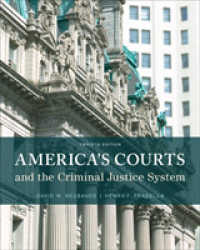Full Description
ALAN J. BISHOP Monash University, Clayton, Victoria, Australia RATIONALE Mathematics Education is becoming a well-documented field with many books, journals and international conferences focusing on a variety of aspects relating to theory, research and practice. That documentation also reflects the fact that the field has expanded enormously in the last twenty years. At the 8th International Congress on Mathematics Education (ICME) in Seville, Spain, for example, there were 26 specialist Working Groups and 26 special ist Topic Groups, as well as a host of other group activities. In 1950 the 'Commission Internationale pour I 'Etude et l' Amelioration de l'Enseignement des Mathematiques' (CIEAEM) was formed and twenty years ago another active group, the 'International Group for the Psychology of Mathematics Education' (PME), began at the third ICME at Karlsruhe in 1976. Since then several other specialist groups have been formed, and are also active through regular conferences and publications, as documented in Edward Jacobsen's Chapter 34 in this volume.
Contents
Curriculum, Goals, Contents, Resources.- to Section 1.- 1: Goals of Mathematics Teaching.- 2: Using and Applying Mathematics in Education.- 3: Number and Arithmetic.- 4: Designing Curricula for Teaching and Learning Algebra.- 5: Space and Shape.- 6: Data Handling.- 7: Probability.- 8: Functions and Calculus.- 9: Assessment.- 10: 'This is so': a text on texts.- 11: Concrete Materials in the Classroom.- 12: Calculators in the Mathematics Curriculum: the Scope of Personal Computational Technology.- 13: Computer-Based Learning Environments in Mathematics.- Teaching & Learning Mathematics.- to Section 2.- 14: Elementary School Practices.- 15: Junior Secondary School Practices.- 16: Senior Secondary School Practices.- 17: Further Mathematics Education.- 18: Higher Mathematics Education.- 19: Critical Issues in the Distance Teaching of Mathematics and Mathematics Education.- 20: Adults and Mathematics (Adult Numeracy).- 21: Popularization: Myths, Massmedia and Modernism.- Perspectives & Interdisciplinary Contexts.- to Section 2.- 22: Epistemologies of Mathematics and of Mathematics Education.- 23: Proof and Proving.- 24: Ethnomathematics and Mathematics Education.- 25: Research and Intervention Programs in Mathematics Education: A Gendered Issue.- 26: Language Factors in Mathematics Teaching and Learning.- 27: Anthropological Perspectives on Mathematics and Mathematics Education.- 28: The Role of Theory in Mathematics Education and Research.- Social Conditions & Perspectives on Professional Development.- to Section 2.- 29: Didactics of Mathematics and the Professional Knowledge of Teachers.- 30: Preparing Teachers to Teach Mathematics: A Comparative Perspective.- 31: Inservice Mathematics Teacher Education: The Importance of Listening.- 32: Teachers as Researchers inMathematics Education.- 33: The Mathematics Teacher and Curriculum Development.- 34: International Co-operation in Mathematics Education.- 35: Critical Mathematics Education.- 36: Towards Humanistic Mathematics Education.- Name Index.






